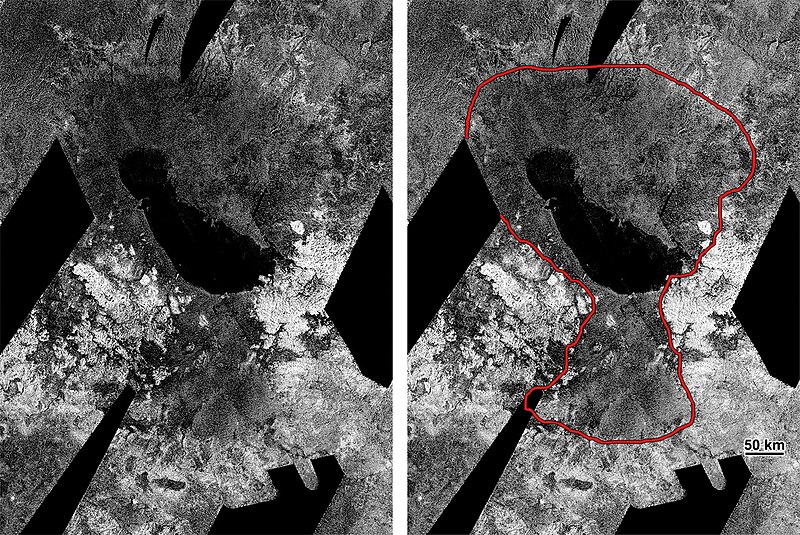File:PIA16166 Ontario Lacus.jpg

Original file (1,320 × 883 pixels, file size: 817 KB, MIME type: image/jpeg)
| This is a file from the Wikimedia Commons. The description on its description page there is shown below.
|
Summary
| DescriptionPIA16166 Ontario Lacus.jpg |
English: This image from NASA's Cassini spacecraft shows an ancient southern sea that used to sprawl near the south pole of Saturn's moon Titan. In the annotated version (on the right), the red outline traces the ancient shoreline. Within this basin is the largest present-day lake in Titan's southern hemisphere, Ontario Lacus. Ontario Lacus appears black, indicating it is filled with liquid.
This image was obtained by Cassini's radar instrument in July 2009 and January 2010. Several images have been stitched together. By analyzing these images, scientists estimate the ancient sea was possibly as large as 300 by 170 miles (475 by 280 kilometers) across and likely less than a few hundred feet (meters) deep. Ontario Lacus is about 80 by 235 kilometers across, and probably at least 30 feet (10 meters) deep at its center. Seas may have covered large parts of the southern hemisphere less than 50,000 years ago. Titan, Saturn's largest moon, is the only place besides Earth in our solar system that hosts large open bodies of liquid. At the cold temperatures of Titan, about minus 290 degrees Fahrenheit (94 kelvins), that liquid is not water, but methane and ethane. Over one hundred lakes and three seas are seen at the north pole of Titan, while the south pole only has a few small lakes. Scientists have suggested that cycles analogous to Croll-Milankovich cycles on Earth cause long-term cyclic transfer of liquid hydrocarbons from pole to pole, with the north pole now containing the bulk of the liquids. Less than 50,000 years ago, the cycle would have been reversed, suggesting that the south polar region should contain remnants of southern seas. The Cassini-Huygens mission is a cooperative project of NASA, the European Space Agency and the Italian Space Agency. NASA's Jet Propulsion Laboratory, a division of the California Institute of Technology in Pasadena, manages the mission for NASA's Science Mission Directorate, Washington, DC. The Cassini orbiter was designed, developed and assembled at JPL. The radar instrument was built by JPL and the Italian Space Agency, working with team members from the United States and several European countries. |
| Date | |
| Source | http://photojournal.jpl.nasa.gov/catalog/PIA16166 |
| Author | NASA / JPL-Caltech / Agenzia Spaziale Italiana / Proxemy Research |
Licensing
| Public domainPublic domainfalsefalse |
| This file is in the public domain in the United States because it was solely created by NASA. NASA copyright policy states that "NASA material is not protected by copyright unless noted". (See Template:PD-USGov, NASA copyright policy page or JPL Image Use Policy.) |  | |
 |
Warnings:
|
Captions
Items portrayed in this file
depicts
16 October 2012
File history
Click on a date/time to view the file as it appeared at that time.
| Date/Time | Dimensions | User | Comment | |
|---|---|---|---|---|
| current | 21:11, 5 November 2012 | 1,320 × 883 (817 KB) | WolfmanSF | User created page with UploadWizard |
File usage
The following page uses this file:
Metadata
This file contains additional information, probably added from the digital camera or scanner used to create or digitize it.
If the file has been modified from its original state, some details may not fully reflect the modified file.
| Width | 648 px |
|---|---|
| Height | 883 px |
| Bits per component |
|
| Pixel composition | RGB |
| Orientation | Normal |
| Number of components | 3 |
| Horizontal resolution | 72 dpi |
| Vertical resolution | 72 dpi |
| Software used | Adobe Photoshop Elements 9.0 Windows |
| File change date and time | 19:54, 5 November 2012 |
| Exif version | 2.21 |
| Color space | sRGB |
| Image width | 1,320 px |
| Image height | 883 px |
| Date and time of digitizing | 19:44, 5 November 2012 |
| Date metadata was last modified | 11:54, 5 November 2012 |
| Copyright status | Copyright status not set |
| Unique ID of original document | xmp.did:4E6D299AC527E211837DD1F4ECAEA419 |
| IIM version | 7,356 |